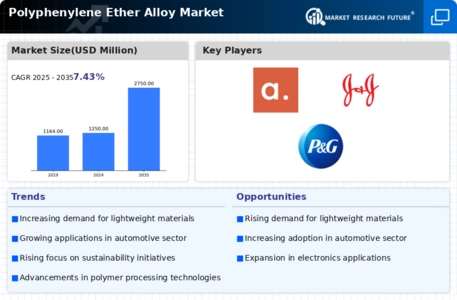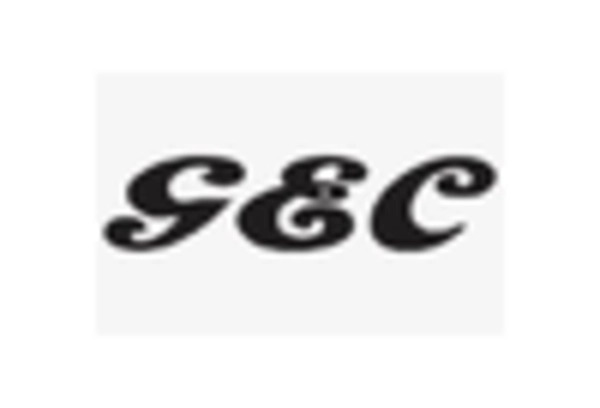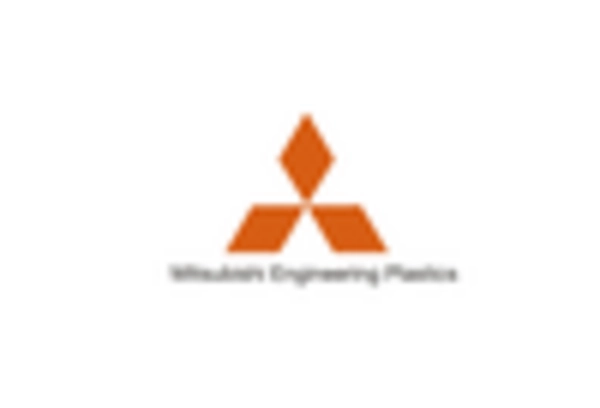Innovations in Recycling Technologies
The Polyphenylene Ether Alloy Market is witnessing a transformative phase due to innovations in recycling technologies. As sustainability becomes a focal point for manufacturers and consumers alike, the ability to recycle polyphenylene ether alloys is gaining traction. Advances in recycling processes not only enhance the environmental profile of these materials but also reduce production costs. The market is likely to see an increase in the adoption of recycled polyphenylene ether alloys, which can provide a competitive edge in terms of sustainability. This shift towards recycling is expected to bolster the Polyphenylene Ether Alloy Market, as companies seek to align with eco-friendly practices while maintaining product performance.
Increasing Applications in Electronics
The Polyphenylene Ether Alloy Market is experiencing a surge in demand due to its increasing applications in the electronics sector. This material is favored for its excellent electrical insulating properties and thermal stability, making it suitable for various electronic components. As the electronics industry continues to expand, driven by innovations in consumer electronics and telecommunications, the need for high-performance materials like polyphenylene ether alloys is likely to grow. In 2025, the market for electronic components is projected to reach substantial figures, further propelling the demand for polyphenylene ether alloys. This trend indicates a robust growth trajectory for the Polyphenylene Ether Alloy Market, as manufacturers seek materials that can withstand the rigors of modern electronic applications.
Rising Demand for Lightweight Materials
The Polyphenylene Ether Alloy Market is benefiting from the rising demand for lightweight materials across various sectors, particularly in automotive and aerospace. As industries strive to improve fuel efficiency and reduce emissions, the shift towards lightweight materials is becoming increasingly pronounced. Polyphenylene ether alloys offer a compelling solution due to their favorable strength-to-weight ratio. In the automotive sector, for instance, the adoption of lightweight materials is projected to grow significantly, with estimates suggesting that lightweighting could lead to a reduction in vehicle weight by up to 20 percent. This trend is likely to drive the demand for polyphenylene ether alloys, positioning the market for substantial growth.
Expansion of Automotive Electric Vehicles
The Polyphenylene Ether Alloy Market is set to benefit from the expansion of the automotive electric vehicle (EV) market. As the automotive industry transitions towards electrification, the demand for high-performance materials that can withstand the unique challenges of EVs is increasing. Polyphenylene ether alloys are particularly suited for applications in electric vehicles due to their thermal stability and electrical insulation properties. With projections indicating a significant rise in EV sales, the Polyphenylene Ether Alloy Market is likely to experience a corresponding increase in demand. This trend suggests a promising future for polyphenylene ether alloys as they become integral to the evolving automotive landscape.
Growth in Construction and Infrastructure
The Polyphenylene Ether Alloy Market is poised for growth, particularly due to the increasing demand in the construction and infrastructure sectors. These alloys are recognized for their durability and resistance to environmental factors, making them ideal for construction materials. As urbanization accelerates and infrastructure projects expand, the need for reliable and long-lasting materials becomes paramount. The construction industry is expected to witness significant investments, with projections indicating a rise in construction spending. This trend suggests that polyphenylene ether alloys will play a crucial role in meeting the material requirements of various construction applications, thereby enhancing the market's growth prospects.

















Leave a Comment